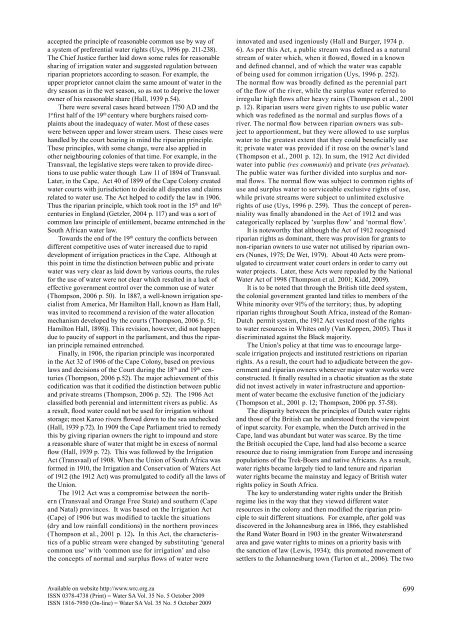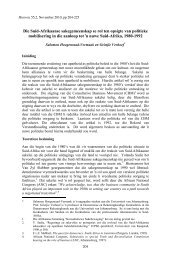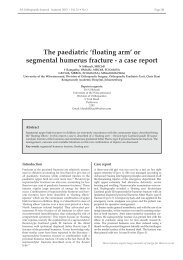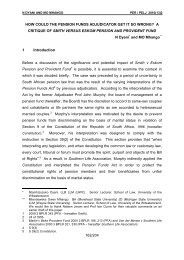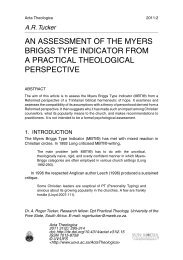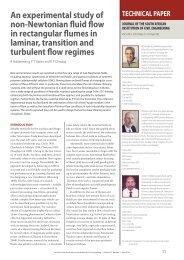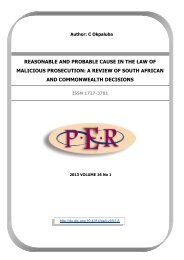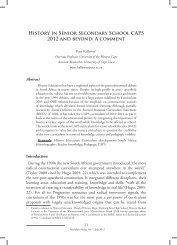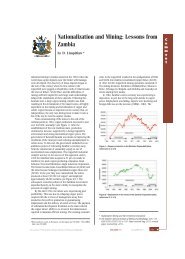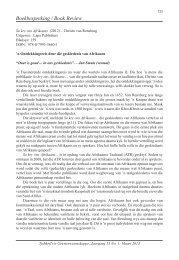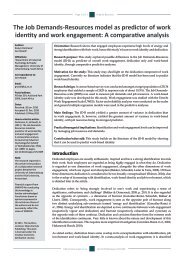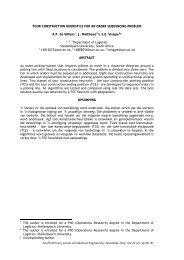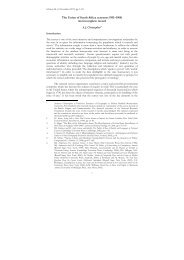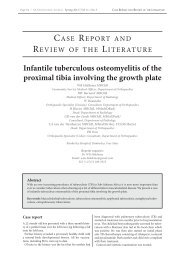A detailed analysis of evolution of water rights in South Africa: An ...
A detailed analysis of evolution of water rights in South Africa: An ...
A detailed analysis of evolution of water rights in South Africa: An ...
Create successful ePaper yourself
Turn your PDF publications into a flip-book with our unique Google optimized e-Paper software.
accepted the pr<strong>in</strong>ciple <strong>of</strong> reasonable common use by way <strong>of</strong><br />
a system <strong>of</strong> preferential <strong>water</strong> <strong>rights</strong> (Uys, 1996 pp. 211-238).<br />
The Chief Justice further laid down some rules for reasonable<br />
shar<strong>in</strong>g <strong>of</strong> irrigation <strong>water</strong> and suggested regulation between<br />
riparian proprietors accord<strong>in</strong>g to season. For example, the<br />
upper proprietor cannot claim the same amount <strong>of</strong> <strong>water</strong> <strong>in</strong> the<br />
dry season as <strong>in</strong> the wet season, so as not to deprive the lower<br />
owner <strong>of</strong> his reasonable share (Hall, 1939 p.54).<br />
There were several cases heard between 1750 AD and the<br />
1 st first half <strong>of</strong> the 19 th century where burghers raised compla<strong>in</strong>ts<br />
about the <strong>in</strong>adequacy <strong>of</strong> <strong>water</strong>. Most <strong>of</strong> these cases<br />
were between upper and lower stream users. These cases were<br />
handled by the court bear<strong>in</strong>g <strong>in</strong> m<strong>in</strong>d the riparian pr<strong>in</strong>ciple.<br />
These pr<strong>in</strong>ciples, with some change, were also applied <strong>in</strong><br />
other neighbour<strong>in</strong>g colonies <strong>of</strong> that time. For example, <strong>in</strong> the<br />
Transvaal, the legislative steps were taken to provide directions<br />
to use public <strong>water</strong> though Law 11 <strong>of</strong> 1894 <strong>of</strong> Transvaal.<br />
Later, <strong>in</strong> the Cape, Act 40 <strong>of</strong> 1899 <strong>of</strong> the Cape Colony created<br />
<strong>water</strong> courts with jurisdiction to decide all disputes and claims<br />
related to <strong>water</strong> use. The Act helped to codify the law <strong>in</strong> 1906.<br />
Thus the riparian pr<strong>in</strong>ciple, which took root <strong>in</strong> the 15 th and 16 th<br />
centuries <strong>in</strong> England (Getzler, 2004 p. 117) and was a sort <strong>of</strong><br />
common law pr<strong>in</strong>ciple <strong>of</strong> entitlement, became entrenched <strong>in</strong> the<br />
<strong>South</strong> <strong>Africa</strong>n <strong>water</strong> law.<br />
Towards the end <strong>of</strong> the 19 th century the conflicts between<br />
different competitive uses <strong>of</strong> <strong>water</strong> <strong>in</strong>creased due to rapid<br />
development <strong>of</strong> irrigation practices <strong>in</strong> the Cape. Although at<br />
this po<strong>in</strong>t <strong>in</strong> time the dist<strong>in</strong>ction between public and private<br />
<strong>water</strong> was very clear as laid down by various courts, the rules<br />
for the use <strong>of</strong> <strong>water</strong> were not clear which resulted <strong>in</strong> a lack <strong>of</strong><br />
effective government control over the common use <strong>of</strong> <strong>water</strong><br />
(Thompson, 2006 p. 50). In 1887, a well-known irrigation specialist<br />
from America, Mr Hamilton Hall, known as Ham Hall,<br />
was <strong>in</strong>vited to recommend a revision <strong>of</strong> the <strong>water</strong> allocation<br />
mechanism developed by the courts (Thompson, 2006 p. 51;<br />
Hamilton Hall, 1898)). This revision, however, did not happen<br />
due to paucity <strong>of</strong> support <strong>in</strong> the parliament, and thus the riparian<br />
pr<strong>in</strong>ciple rema<strong>in</strong>ed entrenched.<br />
F<strong>in</strong>ally, <strong>in</strong> 1906, the riparian pr<strong>in</strong>ciple was <strong>in</strong>corporated<br />
<strong>in</strong> the Act 32 <strong>of</strong> 1906 <strong>of</strong> the Cape Colony, based on previous<br />
laws and decisions <strong>of</strong> the Court dur<strong>in</strong>g the 18 th and 19 th centuries<br />
(Thompson, 2006 p.52). The major achievement <strong>of</strong> this<br />
codification was that it codified the dist<strong>in</strong>ction between public<br />
and private streams (Thompson, 2006 p. 52). The 1906 Act<br />
classified both perennial and <strong>in</strong>termittent rivers as public. As<br />
a result, flood <strong>water</strong> could not be used for irrigation without<br />
storage; most Karoo rivers flowed down to the sea unchecked<br />
(Hall, 1939 p.72). In 1909 the Cape Parliament tried to remedy<br />
this by giv<strong>in</strong>g riparian owners the right to impound and store<br />
a reasonable share <strong>of</strong> <strong>water</strong> that might be <strong>in</strong> excess <strong>of</strong> normal<br />
flow (Hall, 1939 p. 72). This was followed by the Irrigation<br />
Act (Transvaal) <strong>of</strong> 1908. When the Union <strong>of</strong> <strong>South</strong> <strong>Africa</strong> was<br />
formed <strong>in</strong> 1910, the Irrigation and Conservation <strong>of</strong> Waters Act<br />
<strong>of</strong> 1912 (the 1912 Act) was promulgated to codify all the laws <strong>of</strong><br />
the Union.<br />
The 1912 Act was a compromise between the northern<br />
(Transvaal and Orange Free State) and southern (Cape<br />
and Natal) prov<strong>in</strong>ces. It was based on the Irrigation Act<br />
(Cape) <strong>of</strong> 1906 but was modified to tackle the situations<br />
(dry and low ra<strong>in</strong>fall conditions) <strong>in</strong> the northern prov<strong>in</strong>ces<br />
(Thompson et al., 2001 p. 12). In this Act, the characteristics<br />
<strong>of</strong> a public stream were changed by substitut<strong>in</strong>g ‘general<br />
common use’ with ‘common use for irrigation’ and also<br />
the concepts <strong>of</strong> normal and surplus flows <strong>of</strong> <strong>water</strong> were<br />
<strong>in</strong>novated and used <strong>in</strong>geniously (Hall and Burger, 1974 p.<br />
6). As per this Act, a public stream was def<strong>in</strong>ed as a natural<br />
stream <strong>of</strong> <strong>water</strong> which, when it flowed, flowed <strong>in</strong> a known<br />
and def<strong>in</strong>ed channel, and <strong>of</strong> which the <strong>water</strong> was capable<br />
<strong>of</strong> be<strong>in</strong>g used for common irrigation (Uys, 1996 p. 252).<br />
The normal flow was broadly def<strong>in</strong>ed as the perennial part<br />
<strong>of</strong> the flow <strong>of</strong> the river, while the surplus <strong>water</strong> referred to<br />
irregular high flows after heavy ra<strong>in</strong>s (Thompson et al., 2001<br />
p. 12). Riparian users were given <strong>rights</strong> to use public <strong>water</strong><br />
which was redef<strong>in</strong>ed as the normal and surplus flows <strong>of</strong> a<br />
river. The normal flow between riparian owners was subject<br />
to apportionment, but they were allowed to use surplus<br />
<strong>water</strong> to the greatest extent that they could beneficially use<br />
it; private <strong>water</strong> was provided if it rose on the owner’s land<br />
(Thompson et al., 2001 p. 12). In sum, the 1912 Act divided<br />
<strong>water</strong> <strong>in</strong>to public (res communis) and private (res privatae).<br />
The public <strong>water</strong> was further divided <strong>in</strong>to surplus and normal<br />
flows. The normal flow was subject to common <strong>rights</strong> <strong>of</strong><br />
use and surplus <strong>water</strong> to serviceable exclusive <strong>rights</strong> <strong>of</strong> use,<br />
while private streams were subject to unlimited exclusive<br />
<strong>rights</strong> <strong>of</strong> use (Uys, 1996 p. 259). Thus the concept <strong>of</strong> perenniality<br />
was f<strong>in</strong>ally abandoned <strong>in</strong> the Act <strong>of</strong> 1912 and was<br />
categorically replaced by ‘surplus flow’ and ‘normal flow’.<br />
It is noteworthy that although the Act <strong>of</strong> 1912 recognised<br />
riparian <strong>rights</strong> as dom<strong>in</strong>ant, there was provision for grants to<br />
non-riparian owners to use <strong>water</strong> not utilised by riparian owners<br />
(Nunes, 1975; De Wet, 1979). About 40 Acts were promulgated<br />
to circumvent <strong>water</strong> court orders <strong>in</strong> order to carry out<br />
<strong>water</strong> projects. Later, these Acts were repealed by the National<br />
Water Act <strong>of</strong> 1998 (Thompson et al. 2001; Kidd, 2009).<br />
It is to be noted that through the British title deed system,<br />
the colonial government granted land titles to members <strong>of</strong> the<br />
White m<strong>in</strong>ority over 91% <strong>of</strong> the territory; thus, by adopt<strong>in</strong>g<br />
riparian <strong>rights</strong> throughout <strong>South</strong> <strong>Africa</strong>, <strong>in</strong>stead <strong>of</strong> the Roman-<br />
Dutch permit system, the 1912 Act vested most <strong>of</strong> the <strong>rights</strong><br />
to <strong>water</strong> resources <strong>in</strong> Whites only (Van Koppen, 2005). Thus it<br />
discrim<strong>in</strong>ated aga<strong>in</strong>st the Black majority.<br />
The Union’s policy at that time was to encourage largescale<br />
irrigation projects and <strong>in</strong>stituted restrictions on riparian<br />
<strong>rights</strong>. As a result, the court had to adjudicate between the government<br />
and riparian owners whenever major <strong>water</strong> works were<br />
constructed. It f<strong>in</strong>ally resulted <strong>in</strong> a chaotic situation as the state<br />
did not <strong>in</strong>vest actively <strong>in</strong> <strong>water</strong> <strong>in</strong>frastructure and apportionment<br />
<strong>of</strong> <strong>water</strong> became the exclusive function <strong>of</strong> the judiciary<br />
(Thompson et al., 2001 p. 12; Thompson, 2006 pp. 57-58).<br />
The disparity between the pr<strong>in</strong>ciples <strong>of</strong> Dutch <strong>water</strong> <strong>rights</strong><br />
and those <strong>of</strong> the British can be understood from the viewpo<strong>in</strong>t<br />
<strong>of</strong> <strong>in</strong>put scarcity. For example, when the Dutch arrived <strong>in</strong> the<br />
Cape, land was abundant but <strong>water</strong> was scarce. By the time<br />
the British occupied the Cape, land had also become a scarce<br />
resource due to ris<strong>in</strong>g immigration from Europe and <strong>in</strong>creas<strong>in</strong>g<br />
populations <strong>of</strong> the Trek-Boers and native <strong>Africa</strong>ns. As a result,<br />
<strong>water</strong> <strong>rights</strong> became largely tied to land tenure and riparian<br />
<strong>water</strong> <strong>rights</strong> became the ma<strong>in</strong>stay and legacy <strong>of</strong> British <strong>water</strong><br />
<strong>rights</strong> policy <strong>in</strong> <strong>South</strong> <strong>Africa</strong>.<br />
The key to understand<strong>in</strong>g <strong>water</strong> <strong>rights</strong> under the British<br />
regime lies <strong>in</strong> the way that they viewed different <strong>water</strong><br />
resources <strong>in</strong> the colony and then modified the riparian pr<strong>in</strong>ciple<br />
to suit different situations. For example, after gold was<br />
discovered <strong>in</strong> the Johannesburg area <strong>in</strong> 1866, they established<br />
the Rand Water Board <strong>in</strong> 1903 <strong>in</strong> the greater Wit<strong>water</strong>srand<br />
area and gave <strong>water</strong> <strong>rights</strong> to m<strong>in</strong>es on a priority basis with<br />
the sanction <strong>of</strong> law (Lewis, 1934); this promoted movement <strong>of</strong><br />
settlers to the Johannesburg town (Turton et al., 2006). The two<br />
Available on website http://www.wrc.org.za<br />
ISSN 0378-4738 (Pr<strong>in</strong>t) = Water SA Vol. 35 No. 5 October 2009<br />
ISSN 1816-7950 (On-l<strong>in</strong>e) = Water SA Vol. 35 No. 5 October 2009<br />
699


